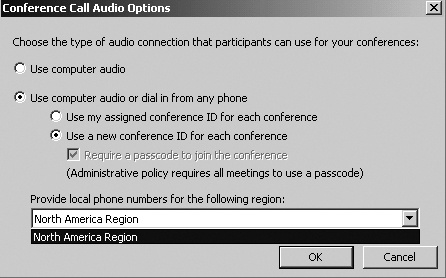This section covers the scenarios applicable to the Response Group Service and Conferencing Attendant. Response Group Service uses speech recognition to provide an interactive user experience to callers and Conferencing Attendant uses DMTF inputs from the user.
The Response Group Service uses different methods to locate an agent to answer the call—these are referred to as routing methods. If no agents are available to answer the call, the call is first queued and then directed to a different destination, such as a voice mail. The transfer to voice mail happens after a configurable time—defined by the queue timeout—has elapsed. While the call is in the queue, music-on-hold can be played back to the caller.
Typical usage scenarios for the Response Group Service are:
Handling the mainline number for an enterprise or any of its offices. In this scenario, the Response Group Service plays a welcome message to the caller and then handles the call differently, depending on whether the call is placed during or outside of business hours.
Handling of calls similar to a small call center, such as a help desk hotline or a departmental help number. In these situations, the caller wants to reach someone from a given department rather than a specific person.
The Response Group Service supports an IVR that can be used to play messages back to the caller, as well as accept input from the caller, to determine how the call should be routed.
The caller input can be accepted in Voice format, for which Voice Recognition is used, or in DTMF format. Messages can be played back to the caller in the form of text, which is read to the caller using text-to-speech technologies, or simply a WAV file that is played to the caller.
The Response Group Service allows for queuing of calls until an agent is found who can answer the call. Typically, music-on-hold is played to the caller while the caller is waiting in the queue. To avoid queues filling up endlessly, the following two metrics are put in place, which when reached, result in an action being taken on the next call to be queued or on existing calls in the queue:
Queue timeout. This setting measures the amount of time a call has spent in a queue.
Queue overflow. This setting measures the number of calls that are allowed to be queued in a given queue.
The action can be to move the call into another queue ("overflow queue") or to route it to another destination, such as voice mail.
Note that the action can be taken on the first call in the queue or on the last call in the queue depending on the result that is desired. If, for example, you want to reduce the amount of time that callers have to wait in the queue and allow them to leave a message and be called back later, the action can be set to route the next call to the queue voice mail after the queue threshold is reached. If, on the other hand, the goal is to add capacity when the call volume is too high, the action can be set to place the first call to the queue (the one that is "oldest" in the queue) into another queue (an overflow queue).
An external user calling from a PSTN phone can join an audio conference on Office Communications Server. The PSTN user dials a phone number associated with the Conferencing Attendant. When prompted, the user enters the conference ID and meeting pass code to get directly connected to the audio portion of the conference.
An organizer (who must be enabled for Office Communications and permitted to schedule meetings) typically schedules a conference using the Microsoft Conferencing Add-in for Microsoft Office Outlook and sends the conference information via email. To enable PSTN callers to attend the audio portion of a meeting, the organizer must allow participants to join the meeting by selecting "Use computer audio or dial in from any phone" option in the Conference Call Audio Options, as shown in Figure 13-1. The "Require a passcode to join the conference" check box, if selected, provides additional security by requiring a pass code to be entered in addition to the conference ID to join the meeting. Because there may be multiple geographic regions in the conference, the region selected needs to be the one to which most of the users in the conference are expected to belong, to give the most optimal experience to users.
To allow PSTN dial-in access to external callers, Invite Anyone must be selected as the access permissions level when creating the meeting, as shown in Figure 13-2. Otherwise, external callers will not be able to join the conference.
In Figure 13-2, the Audio Information section in the body of the conference request shows the details for how to join the conference. The phone numbers listed are associated with the Conferencing Attendant.
Notice the link labeled, Have you set your PIN? shown in Figure 13-2. To configure the Personal Corporate Pin, use the above link. Alternatively, open Office Communicator 2007 R2, and under Tools, select Dial-in Conferencing Settings, as shown in Figure 13-3. This will take the user to the same Web page where they can set their corporate pin number.



